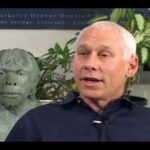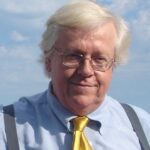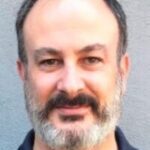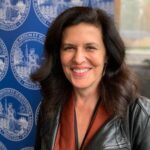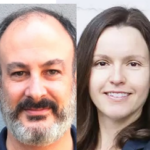John Tooby, Department of Anthropology, University of California, Santa Barbara
While we may not be what we eat, we anthropologists are undeniably what we study: people living a turbulent village life, with enough superstitions, vices, witchcraft accusations, and vitriolic but trivial feuds to furnish the shade of Jonathan Swift with material for a hundred sequels to Gulliver. In recent years, our village has erupted to open conflict as one hard fought theater of the now famous science wars. Scientific anthropologists – in the minority in many departments — have often met with the academic version of ethnic cleansing, while at other places they hang on like barnacles on tidal rocks, or survive through department fissioning. Village fissioning, of course, is just what we teach in introductory anthropology as a method used in many cultures for managing conflict. Stanford, for example, now has two departments of anthropology, the Department of Anthropological Sciences and the Department of Cultural and Social Anthropology(CASA). At one you can study such things as archaeology, religion, gender, environmental anthropology, medical anthropology, linguistics, ethnopoetics, discourse, social anthropology, and so on (that would be Anthropological Sciences), and at the other (Cultural and Social Anthropology) you can study, well, archaeology, religion, gender, environmental anthropology, medical anthropology, etc. Why two departments? Well, there is that provocative adherence by some to scientific folkways with all of their intolerable pretensions. And, oh yes, as the CASA website mildly puts it, “Students interested in biological and evolutionary approaches to anthropology are urged to consult the Department of Anthropological Sciences” (note #1). To many anthropologists, biology if not science itself is the hated Other.
To feuds and fissioning, we add a third classic element of village politics – witchcraft accusations. While to non-anthropologists this recalls the safely buried superstitions of a vanished Salem or, metaphorically, a boozy Joe McCarthy waving lists, anthropologists think of this a bit differently. To us McCarthyism as witchcraft was no metaphor, but an instance of a highly patterned phenomenon that shows up in cultures around the world: accusations of malign or deadly influence – often centering on disease or conspiracy – against individuals who are already disliked by one or more cliques. Such accusations are floated experimentally if the audience seems receptive, and circulate as gossip, flowing through social fissures until enough allies in the projected persecution are ferreted out. At the same time, the threat of guilt by association pressures family, friends, and allies of the target into silence or even denunciation out of self-protection. If the person is disliked by enough (powerful) people in the village, and the supposed harm is sinister enough, the accusations become embroidered collaboratively by the many and enforced as reality on all, regardless of their inherent implausibility or magical nature. The currency of such claims has far more to do with their usefulness in mobilizing opinion against the clique’s enemies and in favor of the accusers than their basis in fact. Did Jewish doctors (as malign as their Weimar banker parents) concoct HIV to eradicate blacks? Do European Gypsies carry disease? Do U.S. citizens in Latin America kidnap babies for their body parts? No less an intellect than Einstein thought the guilt of those put on trial by Stalin to be evident for all to see. Of course, there really are child molesters, and Alger Hiss and Julius Rosenberg (but perhaps not Ethel) really were spies for Stalin. The opportunistic persecution of the innocent can be made to look just like the outraged indictment of the obviously guilty, and vice versa. Witchcraft accusations survive and succeed because of that part in all of us that wants to believe and pass on bad things about those we dislike.
Being what we study, anthropologists make witchcraft accusations, a tactic we have been resorting to with increasing frequency. As Roy D’Andrade, a respected cognitive anthropologist, commented in 1995 (not without an accusatory tone himself).
“The [postmodernist] model does not lead one to do anything positive about bad conditions. Instead, it leads to denunciations of various social practitioners, such as social workers, doctors, psychiatrists, economists, civil servants, bureaucrats, etc., and especially other anthropologists. Isn’t it odd that the true enemy of society turns out to be that guy in the office down the hall?”
Even to the jaded, however, the events of the last few weeks have been eye-opening. Two anthropologists, Terry Turner and Leslie Sponsel, sent a searing, Zola-like letter to both the present and incoming president of the American Anthropological Association, a letter that spread like a virus over the internet. The letter provided their distillation of a series of chilling and sensational “revelations” made by an author, Patrick Tierney, in his forthcoming book Darkness in El Dorado: How Scientists and Journalists Devastated the Amazon. “In its scale, ramifications, and sheer criminality and corruption it is unparalleled in the history of Anthropology” wrote Turner and Sponsel. “It should cause the field to understand how the corrupt and depraved protagonists could have spread their poison for so long while they were accorded great respect throughout the Western World…” The indictment listed a horrifying series of crimes — “beyond the imagining of even a Josef Conrad (though not, perhaps, a Josef Mengele)” — up to and including genocide committed by U.S. scientists against the Yanomamö. The Yanomamö are an indigenous (and suffering) people of perhaps 25,000 scattered through seventy thousand square miles of rainforest in Venezuela and Brazil. They are also the recipients of attention from journalists, anthropologists, Sting concert attendees, missionaries, eco-tourists, miners, and the like.
The accusations were directed primarily against James Neel, a physician and founder of human genetics (now dead), Tim Asch, a famous ethnographic filmmaker (also dead), Napoleon Chagnon, the world’s most famous living social anthropologist, and Neel’s large medical team. Neel, in the indictment, was described as an adherent of “fascistic eugenics” who believed that “mass societies of modern democratic states” were a eugenic mistake, and that “society should be reorganized into small breeding isolates in which genetically superior males could emerge into dominance, eliminating or subordinating the male losers in the competition for leadership and women, and amassing harems of brood females.” Starting in the 1960’s, Neel and his researchers were funded by the Atomic Energy Commission to conduct secret and horrifying medical experiments on the Yanomamö. Far and away the most serious allegation was that the researchers had killed hundreds or thousands through knowingly administering a “virulent vaccine” that released contagious measles virus into the previously unexposed Yanomamö population. As the letter goes on to comment, “Tierney’s well-documented account, in its entirety, strongly supports the conclusion that the epidemic was in all probability deliberately caused as an experiment designed to produce scientific support for Neel’s eugenic theory.” Chagnon – described by Tierney as a “disciple” of Neel’s eugenics theories – was implicated in this crime, and of having introduced warfare and numerous diseases into the Yanomamö, of staging events for his films, and generally twisting his scholarly portrayal of the Yanomamo to make them conform to “Neel’s ideal alpha-male-dominated groups.”
I was an early recipient of this ethics complaint, in that small number of internet nanoseconds when it was still considered confidential. As president of the Human Behavior and Evolution Society (HBES), of which Chagnon was a prominent member, I was obligated to investigate such serious allegations, just as the American Anthropological Association would be doing. While the letter was scientifically illiterate, and the X-Files plot line seemed more than a bit implausible, still, I thought, there could well be some core of truth here. Why would someone go to all this work, risking exposure, if there was nothing to it? The publisher, Norton, is very well-respected among academics. Moreover, as Turner and Sponsel pointed out, The New Yorker was going to publish an excerpt (out in this week’s issue as A reporter at large). They were notorious for their obsessive fact-checking (although they do make mistakes, e.g., calling HBES “prestigious”). The most reasonable gloss was that Neel as a physician had unintentionally made some medical misjudgment that had cost lives. But – who knew? – perhaps he really was a eugenics crackpot, exploiting the isolation of his fieldsite in some horrible way. While I had never met Neel, Chagnon had been my departmental colleague and friend for the past decade (click here for full disclosure), ever since I had moved to the University of California, at Santa Barbara.
The first thing I did was to pull Neel’s scientific autobiography from my shelf where it had been sitting unread and look up what it said about the measles epidemic. His own account (a cover up?) sounded just like what a humane doctor and scientist would do and think: fight outbreaks, sometimes desperately, through prevention and treatment.
Nevertheless, Tierney alleged that the vaccine Neel’s team used, Edmonston B, was a dangerous agent and known to be so at the time, and identified it as the source of the deadly epidemic. To my nonspecialist ears, this sounded logically possible, if surprising: Many vaccines, including measles vaccine (then and now), use attenuated live virus, which when injected is designed to give the recipient an infection related to or derived from the actual disease it is intended to inoculate against. The immune system fights off this less damaging infection through generating antibodies that then are effective against the actual and more deadly disease, when encountered. So when you strip away the reassuring language, vaccinations are after all the deliberate infection of the injected individual. But doctors do this fearful sounding thing because the trade-off is, on a statistical basis, overwhelmingly beneficial, and millions of lives are saved every year, despite an occasional adverse reaction. So, why couldn’t the attenuated live virus (a replicating organism just like the rest of us) have contagiously spread from Yanomamö to Yanomamö, being rather than impeding the deadly epidemic? You assume that vaccine developers and evaluators know how to do their job, but errors get made in all walks of life.
Moreover, as I sat there with Turner and Sponsel’s email on the one hand, and Neel’s book on the other, it became clear that immediate investigation was more than urgent, whether the truth was heads (Neel’s account) or tails (Tierney’s).
Attenuated live virus vaccines are injected into hundreds of millions of people every year to protect against a whole range of diseases. My little daughter has received a number of such injections, like billions in the developed and developing world.
If it were true that vaccines have the potential to cause epidemics, then this would be the most explosive medical discovery of the last forty years. Researchers at the CDC and elsewhere needed to know immediately so that they could explore the implications and protect vulnerable populations from future mishaps.
On the other hand, if it were false – if vaccines do not cause epidemics — then the matter was equally life-or-death. If reputable sources like The New Yorker published the claim that vaccinations have the potential to cause a deadly epidemic, or even to kill through adverse reactions a large number of recipients, then the ability of health workers to administer immunization programs and other public health measures in underdeveloped areas would be compromised. People, especially in poorer countries, would die as a result – at least in the hundreds, but potentially summing into the thousands or millions. click here to see why.
So, I started putting in calls to the Centers for Disease Control, while scanning the medical literature available on the web. Conversations with various researchers, including eventually Dr. Mark Papania, chief of the U.S. measles eradication program, rapidly discredited every essential element of the Tierney disease scenarios, either in their extreme form (the vaccine caused a deadly epidemic that spread to the unvaccinated) or mild form (the immunization may have killed large numbers of vaccinated individuals through adverse reactions).
One key fact that by itself debunks the central allegation that the vaccine itself caused the epidemic is that researchers at the CDC and elsewhere whose job is to test vaccines for safety have never been able to document, in hundreds of millions of uses, a single case of the contagious transmission of the virus contained in any live virus measles vaccine from one human to another. This is despite their most strenuous efforts to detect just such events. If attenuated live virus does not jump from person to person, it cannot cause an epidemic. Nor can it be planned to cause an epidemic, for reasons of some X-Files eugenics experiment, if it never has previously. This failure to observe transmission has subsequently been confirmed by experts elsewhere, as is the vaccine safety and appropriateness in the conditions in which it was used (Click here to find a statement from the University of Michigan Medical School, on this point and other errors in the Tierney allegations; click here to read statements made by Dr. Samuel L. Katz, a co-developer of the vaccine in question, on studies of Edmonston B vaccine safety and transmission, including in tropical populations with worse health problems than the Yanomamö. Click here for an account by Susan Lindee, a historian of science, on what she found from reading Neel’s field notes.)
You’d think the Tierney book, 10 years in the making, might mention the relevant and easily discoverable fact that, as the Michigan medical report puts it, “Live attenuated vaccine has never been shown to be transmissible from a recipient to a subsequent contact.” Somehow it omits it. The New Yorker piece also fails to mention it, but instead says “Today, scientists still do not know whether people who have been vaccinated with Edmonston B can transmit measles.” This is of course literally true, but only because scientists use the word know very carefully. Scientists also do not know whether The New Yorker is riddled with a cult of paedophilic satan worshipers, or that the Pentagon is not in the control of extraterrestrials masquerading as generals. If you ask a good scientist about each of these allegations, she would be forced to answer, yes, it’s possible. But she will consider it relevant and worth mentioning, as The New Yorker does not, that researchers had worked hard to detect just such events, and had failed to detect any, despite millions of opportunities to do so.
My first few hours of reading the medical literature, and my conversations with the CDC panicked me. I knew that a number of newspapers and magazines in addition to The New Yorker were getting ready to run with a story that was turning out to be almost certainly false in substance, and one with the potential to damage the delivery of medical treatment to thousands of the world’s poorest and most vulnerable. On the first day I called, no one that I talked to at the CDC had heard of the book or its allegations, so I filled them in on the book and its importance for their immunization programs, and urged them to get in touch with the journalists who I knew were working on the story. Reciprocally, the next several days were a frenzy of calling, faxing and emailing journalists, offering contact information about medical researchers at the CDC and elsewhere who had studied vaccines. I asked (pleaded) with the journalists to not simply recycle the sensational allegations but to hold off until they could do their own original reporting and interview individuals who could provide expert evaluations of the central claims. Like Neel’s firebreaks, this seemed to be working until the Guardian broke the story under the headline Scientist ‘killed Amazon indians to test race theory’. That was also the day I was finally able to get a copy of the proofs to Tierney’s book, and to evaluate it line by line against sources and references I could consult.
What was the book like? Although each chapter initially carried substantial persuasive force because of the number and intricacy of the allegations, the density of the documentation, and the sheer number of people quoted, anywhere I scratched the surface even the tiniest bit a massive tangle of fun-house falsity would erupt through. As a colleague wonderingly commented to me after reading a chapter, “I thought if you were going to lie on this scale, you would have to be clever.” Unfortunately, scores of conversations reported in the book are with people that are virtually impossible to contact, scattered through the rainforest as they are. Tierney’s veracity with those would have to be judged on the basis of his reliability in reporting from sources that can be reached. Still, there is one class of sources that can be evaluated by everyone without their being the least ambiguity as to what they actually said. These are the contents of published materials that Tierney cites and describes. Comparing Neel’s autobiography with Tierney’s use of it is by itself an education in audacity. Neel had been a fierce opponent of eugenics for sixty years, not a eugenicist, and at various points throughout the book Neel roundly criticizes every doctrine or position that would distinguish a geneticist from a eugenicist. And whatever right-wing or fascist might mean, Neel’s book shows him to be a Gore-supporting, Reagan-Bush bashing, pro-nuclear disarmament environmentalist. With comic incoherence, Tierney even argues that Neel was a eugenicist because he thought that the Yanomamö and other New World populations might be less genetically different from Old World populations than had been supposed by others.
This pattern of falsification is maintained by every other source so far consulted. Far from being contradicted by other studies, Chagnon’s results on rates of Yanomamö conflict and homicide were squarely in line with what every other data-based study of non-state societies had shown. Chagnon couldn’t, as alleged, have been the cause of Yanomamö warfare, because it had been going on long before his birth or arrival, as was remarked on by all prior observers, and shown by ethnohistorical research. And so on, endlessly. Throughout, Tierney is hilariously self-aggrandizing on himself as an investigative reporter, as when he says “It took me quite a while to penetrate Chagnon’s data, but, by combining visits to the villages in the field with GPS locations and mortality statistics, I can identify nine of the twelve villages where all the murderers come from in his Science article…” Or, if he didn’t want to do all that walking and calculating, he could have remembered that he had read this information in the publications Tierney cites when it suits him.
Halfway through, I pulled out a dictionary and looked up hoax – “to trick into believing or accepting as genuine something that is false and often preposterous.” Of course, only Tierney can testify positively as to whether Darkness in El Dorado is a deliberate hoax, but it took only a few hours of cross-checking between text and sources to reveal that the book was systematically organized to get the reader to accept “as genuine something that is false and often preposterous.” It is also the most successful hoax on the publishing world since Clifford Irving’s “autobiography” of Howard Hughes.
The galleys also raised questions about Turner and Sponsel, who have been bitter academic adversaries of Chagnon for years. As Lou Marano of UPI put it:
“Those who have seen galley proofs of “Darkness in El Dorado” say the kind of credit Tierney gives to Turner and Sponsel is consistent with a long-standing collaboration. Far from being surprised by the contents of the proofs and thus galvanized into action, as claimed, Turner and Sponsel seem certain to have been two of Tierney’s principal sources.”
What does this mean? Given the grave public health implications if the allegations were either true or false, any decent person – even ice-hearted people like us scientists are known to be – would urgently want to find out the truth of the matter. It had taken me, for example, only a few hours to discover that the primary allegations in the Turner/Sponsel email were almost certainly false. But Turner and Sponsel had had enormous amounts of time to investigate – when they read over the manuscript (if not before), as they wrote rave reviews for the publisher and Amazon, as they drafted and circulated their extensive indictment for the AAA, as they talked to the Guardian and others… Whatever Chagnon and Neel might have done decades ago in distant places, it is hard to avoid the conclusion that Turner and Sponsel were willing to jeopardize lives in the developing world in order to settle academic scores here in the U.S..
With expert after expert coming forward on various aspects of the book, the accusations against Neel and Chagnon “are crumbling by the hour” as Marano puts it (click here to read an evaluation of evidence that films were staged). Even Turner has recently conceded that the vaccine expert he finally consulted took Tierney’s medical claims and, like others, has “refuted them point by point.”
Of course, the fact that Joe McCarthy victimized innocent people does not mean he was wrong about everything. Similarly, Tierney’s book and its excerpt are thick with allegations against Neel, Chagnon and colleagues, and its Oliver Stone/JFK arguments will take a long time to untangle. Although no investigated charge against Neel, Asch, or Chagnon has so far stood up to critical scrutiny, those not already debunked will still have be investigated. Misconduct wherever it is found deserves to be exposed and redressed.
Nevertheless, it bears noting that the remaining claims boil down to the ancient game of “You and your friends cause disease and war, me and my friends don’t.” Such accusations are hard to refute, which is why they are favored in witchcraft accusations. Since all of us shed virus and bacteria, we are all not only potential but actual sources of infection to others. So it is perfectly possible that, as Tierney argues, Chagnon is the source of numerous epidemics among the Yanomamö. (Of course, Tierney traveled to the same places, shedding as he went, and on each of his six trips he also failed to supply the year of follow up medical care he chastises Chagnon for not supplying.) There is nothing wrong with asking whether anthropologists and others like Tierney ought to stay home in the U.S., rather than traveling to other continents. In any case, given the invisibility and untrackability of a great deal of disease transmission, particularly over tens of thousands of square miles of rainforest, exact answers will never be known. But probabilities can be assessed, and here is where Tierney fails to mention some very large, very important facts that call his entire account into the most serious question.
First, he presents the Yanomamö as if they were isolated in a petri dish, except when Chagnon visited and sneezed. In reality, the Yanomamö are tens of thousands of people, surrounded on all sides by other people with real diseases who have regular transactions with the Yanomamö. Moreover, this 70,000 square mile area is interpenetrated by thousands of non-Yanomamö: missionaries, gold miners (40,000!), loggers, ranchers, drug smuggers, military personnel, adventurers like Tierney, several other ethnic groups, and on and on. While Chagnon visited for 60 months over 36 years, many of these others, like missionaries, are in continuous occupation. This whole area is beset by epidemics of various kinds, as the less exposed Yanomamö gradually but tragically encounter the diseases carried by all of these people. So, the probability that Chagnon in particular is the source of any specific epidemic is, crudely speaking, one divided by these thousands.
More importantly, to make a justified estimate of who are the major sources of disease, one would need to collect careful demographic data in the villages in various areas, and map it out against these other forms of contact. As it happens, this is just what Chagnon did, and he gradually concluded on the basis of his data that the missions – just as common sense would predict – were serious sources of disease, because of their continuous occupation, their role as points of contant and entry, and so on. Locals immediately around the missions benefited from the medical care, but those close enough to catch their diseases but too far to benefit from mission medical care were being impacted.
Chagnon was undiplomatic enough to write about this, making some in the locally powerful mission system furious with him.
Similarly, Tierney says that the steel tools that Chagnon distributed to the Yanomamö that he visited caused conflicts to break out. This too is logically possible. The Yanomamö certainly valued Chagnon’s gifts, since cutting the jungle back for their gardens was much easier with steel tools than without them. But once again, Tierney omits to mention that Chagnon’s contributions were dwarfed by all of the other sources, such the military (who hired local laborers), and the vast mission system, which imports boatloads of goods, and even has its own airline.
While he is critical of Chagnon’s distribution of trade goods, he is silent on the far more shocking practice by some missionaries of distributing shotguns and ammunition among the Yanomamö – weapons that are known to have been used in raiding.
Chagnon was undiplomatic enough to write about this too, and to criticize certain missionaries in the New York Times and elsewhere (he speaks very warmly of others). Because of the political consequences of Chagnon’s protests, he has been kept out of the area since the early 1990’s by missionary hostility. Chagnon, desperate to help the Yanomamö in the face of these problems, proposed an Amazonian biosphere that would sharply limit exploitive contact by outsiders. This proposal was also strongly opposed by powerful missionary institutions.
In short, what Tierney has left out is that what the missionaries and their allies have accused Chagnon of – causing disease and warfare – coincidentally just happens to be what Chagnon had previously accused some of them of doing, and in public forums with data. Indeed, a prerequisite of Tierney’s ability to work in the area and gather material for his book was almost certainly his endorsement of one side in this feud. The permissions, the translators, the guides, the selection of interviewees – all carry the strong implication that Tierney was complicit in a guided tour drenched with these local politics. When this context is supplied, the unremitting denunciations of Chagnon start to sound rather different, and Tierney appears in a new light.
Isn’t it odd that the true enemy of the Yanomamo turns out to be that guy in the office down the hall?
In the meantime, the plight of indigenous peoples around the world worsens, and this thoroughly dishonest book is just one more abuse of the Yanomamö. (If you are interested in the conditions of indigenous peoples, click here).
NOTES
Note 1:
Although the members of the Department of Cultural and Social Anthropology cannot quite bring themselves to actually link to their ostracized former colleagues on their opening page in the way the Dept. of Anthropological Science does to them.
Note 2:
Full disclosure
Though friends, Chagnon and I have had our disagreements: Amazingly, he recently rejected a paper of mine from a volume he was editing because of our theoretical differences. Moreover, he viewed with genial contempt my laboratory-based efforts to study human nature, considering them ecologically less valid than observations of real people making decisions with real consequences in the course of their daily lives. Nonetheless, his narrow sect and my narrow sect are both parts of the same larger movement of researchers who consider evolved human nature to be something more than a blank slate, and eminently worthy of study.
Moreover, unlike many anthropologists, I am not repelled by Chagnon’s view that the prudent and tactical use of violence is one setting on the dial of human nature, just like love, fascination, or sexual desire – and one that can be found in all cultures. One would think it did not have to be said were it not so widely misunderstood, but to investigate something like disease or war is not to endorse it. Hard as it is to believe, people might even study something because they want to eliminate it.
Note 3:
Neel’s account
Neel discovered on the basis of earlier blood antibody profiles of the Yanomamö that the great majority of Yanomamö had not been exposed to measles, but that some had. Neel wrote that this situation “posed a major potential threat, since the tragic impact of measles on what is termed a ‘virgin soil’ population has been well-documented.” That is, lit matches were being dropped around the oily rags, and though a few scattered rags had gone up without igniting the others, it was only a matter of time. Then, immediately prior to his departure into the field, he discovered that measles had already broken out among the Brazilian Yanomamö only two days travel from his site, and so he acquired vaccine for a planned program of preventive immunization (“fire breaks”) in the Venezuelan area where he would be working. This plan was overtaken by events because when they arrived at the field site, Brazilians were already there, and measles had broken out. What followed was a mad scramble to immunize, treat the secondary complications with antibiotics, and yet stay ahead of the epidemic to keep it from spreading too far beyond its points of entry.
Note 4:
Medical harm
Here is part of what I faxed or emailed to various journalists at the time: Lives are at stake: Before anything else it is vital that you realize the following. If [fill in the blank] publishes the claim (one that can be readily debunked) that vaccinations caused a deadly epidemic, then the ability of others to administer immunization programs and other public health measures in underdeveloped areas will be compromised, and people will die as a result — certainly in the thousands, possibly in the millions.
This is no exaggeration for effect: Many news organs, politicians, and officials (not to mention demagogues) in developing countries are less interested in truth than in political opportunism and sensation. Once a reputable first world source such as [fill in the blank] puts its prestige behind such a claim (even if it is hedged), no subsequent retraction will ever catch up with it or undo the damage. Outside of genocide, infectious disease remains the most significant cause of early death and ongoing suffering in developing countries. The ability to obtain cooperation and consent for public health measures and eradication programs in such areas depends on maintaining an accurate perception of the safety and benefits of these measures, based on the best evidence available. We know from numerous examples in the past the self-destructive hysteria that can arise from unfounded claims that sinister groups and individuals were the cause of epidemics – from Jews to Gypsies to witches and foreigners. It would be a tragedy of the first order if those who were the best hope for preventing disease – medical practioners – became popularly identified as the source of disease. Once such myths start, they can persist over many years, compounding the damage.
Already, a durable and dangerous myth in Central and South America is that infants and children are regularly kidnapped by U.S. citizens for their body parts. A claim that vaccination programs have caused epidemics, and moreover were intended to do so, will impede what the poor in tropical countries need most: effective efforts to reduce or eradicate parasitic and infectious diseases. According to WHO, measles vaccination by itself is estimated to save millions of lives around the world, and it is unlikely that the negative effects of such sensational claims will be limited to the measles eradication program. It is likely to spill over onto many other public health measures and research programs funded or administered even in part by medical organizations and personnel from developed nations – again, programs on which the health and survival of millions depend. Even relatively enlightened politicians can be pulled into marginal medical theories with large scale public health effects, as witnessed by South African President Thabo Mbeki’s recent repudiation of consensus views of the causes of and treatments for AIDS. And there is a whole spectrum of the less responsible and less well-intentioned: the “Protocols of the Learned Elders of Zion” is regularly cited and reprinted by locally prestigious media in developing countries, despite endless efforts to have its origins as a forgery recognized.
So this is unlike almost any other editorial decision you will be called on to make, because what you do now – or fail to do – will lead to lives saved or lives lost.
Note 5:
Journalism working
For example, The Washington Post pulled their story before publication, I was told by people who were in contact with them. John Noble Wilford at the New York Times held off to investigate, and the resulting cautious story was only posted for a day – unlike the usual practice of leaving it on the science page for a week.
Note 6:
Getting the book
One very bad sign was that no scientifically oriented anthropologist that I could find had been given a copy of the proofs of the Tierney book – and Norton had not even sent a set to Chagnon or members of Neel’s medical team for comment. Fortunately, friendships cross the science boundary.
Note 7:
Because so many of Tierney’s allegations are based on his report of conversations with individuals who cannot practically be consulted, Tierney’s credibility becomes a prime issue. This was flagged for me early on, when Mark Papania of the CDC called me. While I wanted to talk about vaccine safety, he wanted to talk about Tierney. He told me that he had spoken to Tierney some years before. He then volunteered that he was troubled to find, in proofs he had recently been sent and was beginning to go over, that Tierney had quoted him very inaccurately. For example, Tierney had him endorsing the idea that the vaccine had plausibly caused an epidemic, when he had told Tierney the opposite.
Note 8:
For a typical example, Tierney cites a study by Redmond that he claims refutes Chagnon’s finding among the Yanomamo that the effective use of violence contributes to social status and wife acquisition.
Among the Jivaro, head-hunting was a ritual obligation of all males and a required male initiation for teenagers… Among the Jivaro leaders, however, those who captured the most heads had the fewest wives, and those who had the most wives captured the fewest heads. (Tierney, p. 178 of the proofs).
Here is what Redmond actually says:
Yanomamo men who have killed tend to have more wives, which they have acquired either by abducting them from raiding villages, or by the usual marriage alliances in which they are considered more attractive as mates. The same is true of Jivaro war leaders, who might have four to six wives; as a matter of fact, a great war leader on the Upano River in the 1930s by the name of Tuki of José Grande had eleven wives. Distinguished warriors also have more offspring, due mainly to their greater marital success (Redmond 1994, p. 125).
Note 9:
Neel’s account of the epidemic is on pages 161 – 165 Physician to the gene pool. 1994 New York: John Wiley and Sons.

